The Sterile Tubing Welders Market is estimated to be valued at USD 2.7 billion in 2025 and is projected to reach USD 4.7 billion by 2035, registering a compound annual growth rate (CAGR) of 5.7% over the forecast period.
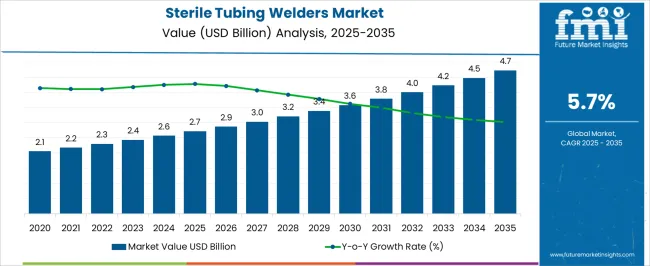
| Metric | Value |
|---|---|
| Sterile Tubing Welders Market Estimated Value in (2025 E) | USD 2.7 billion |
| Sterile Tubing Welders Market Forecast Value in (2035 F) | USD 4.7 billion |
| Forecast CAGR (2025 to 2035) | 5.7% |
The sterile tubing welders market is witnessing steady expansion, supported by rising adoption in biopharmaceutical manufacturing, clinical research, and healthcare facilities where sterile fluid transfer is critical. The growing demand for single-use technologies, driven by bioprocessing and cell and gene therapy production, is stimulating greater reliance on sterile welding systems to ensure contamination-free connections. Advancements in automation, precision engineering, and ease of integration with existing bioprocessing systems are improving operational efficiency and reducing manual errors.
Increasing regulatory emphasis on maintaining high levels of sterility in pharmaceutical and medical production environments is further strengthening market growth. Hospitals and laboratories are also adopting sterile tubing welders to support transfusion, blood processing, and sterile sample handling, reinforcing their importance beyond large-scale manufacturing.
As healthcare infrastructure expands globally and investments in biologics manufacturing increase, the demand for advanced sterile connection technologies is expected to accelerate The ability of these systems to provide repeatability, compliance, and safety positions the sterile tubing welders market for continued growth in the coming years.
The sterile tubing welders market is segmented by application, mode, end users, and geographic regions. By application, sterile tubing welders market is divided into Biotechnology, Pharmaceutical, Laboratories, and Others. In terms of mode, sterile tubing welders market is classified into Automatic and Manual. Based on end users, sterile tubing welders market is segmented into Hospitals, Research Clinics, Industries, and Others. Regionally, the sterile tubing welders industry is classified into North America, Latin America, Western Europe, Eastern Europe, Balkan & Baltic Countries, Russia & Belarus, Central Asia, East Asia, South Asia & Pacific, and the Middle East & Africa.
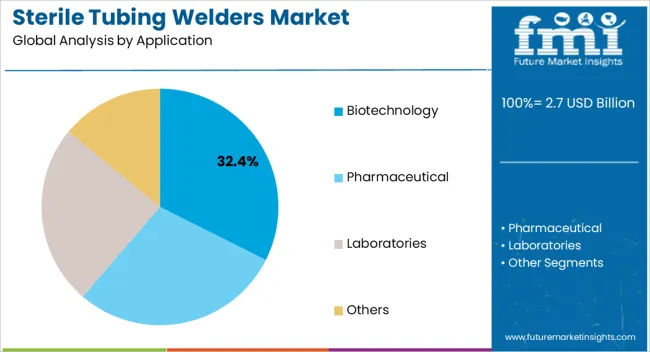
The biotechnology application segment is projected to account for 32.4% of the sterile tubing welders market revenue share in 2025, positioning it as the leading application area. This leadership is being driven by the rapid growth of biologics, vaccines, and cell-based therapies, which require sterile fluid management systems to ensure product quality and compliance.
The increasing adoption of single-use bioprocessing systems in biotechnology facilities is reinforcing demand for sterile tubing welders, as they provide contamination-free welding of thermoplastic tubing essential for upstream and downstream processes. The segment is also benefiting from rising investments in research and development by pharmaceutical and biotech companies to accelerate drug discovery and production timelines.
Regulatory bodies continue to emphasize sterility and contamination control in biopharmaceutical manufacturing, which is pushing companies to rely on automated and validated sterile connection methods As the biotechnology industry continues to expand globally with a focus on personalized medicine and advanced therapeutics, sterile tubing welders are expected to remain integral to ensuring safety, efficiency, and scalability in production environments.
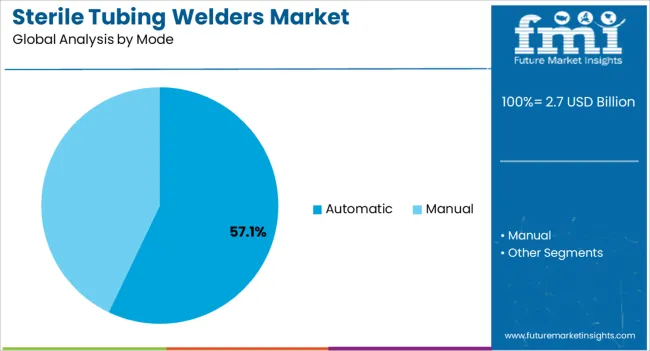
The automatic mode segment is anticipated to represent 57.1% of the sterile tubing welders market revenue share in 2025, making it the dominant mode of operation. This preference is being driven by the ability of automatic systems to provide consistent weld quality, reduce manual intervention, and minimize operator error. Automation in sterile tubing welding allows for faster processing, which is crucial in large-scale manufacturing facilities handling high volumes of biologics and medical products.
Growing demand for reliable and reproducible sterile connections in both biotechnology and healthcare settings is supporting this segment’s leadership. The adoption of automatic welders is also being reinforced by advancements in user-friendly interfaces, validation features, and compliance with Good Manufacturing Practice standards.
These systems enable manufacturers to meet stringent sterility requirements while improving productivity and reducing operational costs As the pharmaceutical and medical device industries continue to scale production capacity, the automatic mode of sterile tubing welders is expected to remain the preferred choice, ensuring efficiency, accuracy, and regulatory compliance across applications.
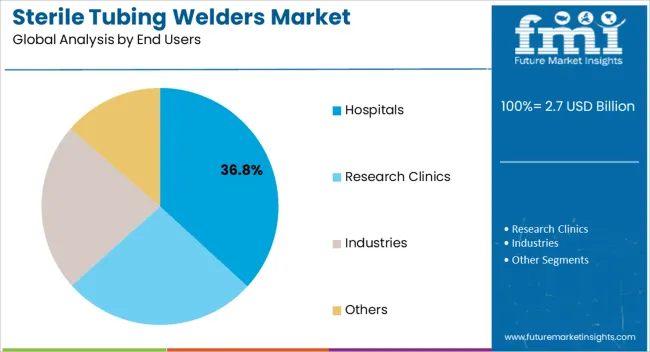
The hospitals segment is expected to capture 36.8% of the sterile tubing welders market revenue share in 2025, establishing itself as the leading end-user category. This dominance is being reinforced by the rising demand for sterile and efficient fluid transfer systems in transfusion centers, blood banks, and hospital laboratories. Hospitals are increasingly relying on sterile tubing welders to ensure safe handling of blood products, intravenous fluids, and other critical biological materials without risk of contamination.
The growing emphasis on infection prevention and patient safety is further stimulating adoption, as healthcare facilities seek advanced solutions that align with regulatory standards and best practices. Additionally, the ability of sterile tubing welders to support flexible workflows and integrate with existing hospital systems is enhancing their utility.
With the increasing volume of medical procedures, expansion of healthcare infrastructure, and growing demand for safe patient care, hospitals are emerging as a central hub for sterile tubing welder adoption This trend is expected to strengthen as healthcare providers continue to prioritize safety, compliance, and operational efficiency.
In 2025, the global Sterile Tubing Welder Market will be worth US$ 2.4 Billion. and is projected to expand steadily at a CAGR of 5.7% to reach a market valuation of close to US$ 4.2 Billion by 2035.
| Attributes | Details |
|---|---|
| Global Sterile Tubing Welder Market Size (2025A) | US$ 2.3 Billion |
| Estimated Market Size (2025E) | US$ 2.4 Billion |
| Projected Market Value (2035F) | US$ 4.2 Billion |
| Value CAGR (2025 to 2035) | 5.7 % |
| Collective Share: Top 3 Countries (2025E) | 26.7% |
North America is anticipated to hold a prominent share of the market owing to the rapid growth of end users in the region. According to FMI, North America will hold 25.3% of the market by 2035.
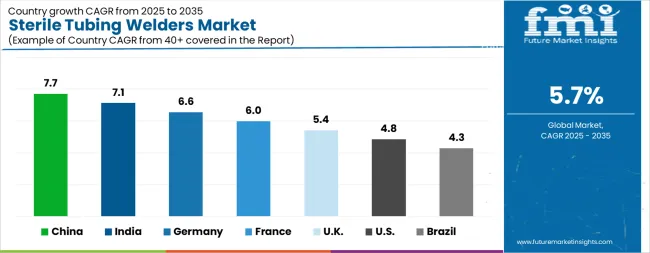
| Country | CAGR |
|---|---|
| China | 7.7% |
| India | 7.1% |
| Germany | 6.6% |
| France | 6.0% |
| UK | 5.4% |
| USA | 4.8% |
| Brazil | 4.3% |
The Sterile Tubing Welders Market is expected to register a CAGR of 5.7% during the forecast period, exhibiting varied country level momentum. China leads with the highest CAGR of 7.7%, followed by India at 7.1%. Developed markets such as Germany, France, and the UK continue to expand steadily, while the USA is likely to grow at consistent rates. Brazil posts the lowest CAGR at 4.3%, yet still underscores a broadly positive trajectory for the global Sterile Tubing Welders Market. In 2024, Germany held a dominant revenue in the Western Europe market and is expected to grow with a CAGR of 6.6%. The USA Sterile Tubing Welders Market is estimated to be valued at USD 979.7 million in 2025 and is anticipated to reach a valuation of USD 1.6 billion by 2035. Sales are projected to rise at a CAGR of 4.8% over the forecast period between 2025 and 2035. While Japan and South Korea markets are estimated to be valued at USD 125.5 million and USD 89.4 million respectively in 2025.
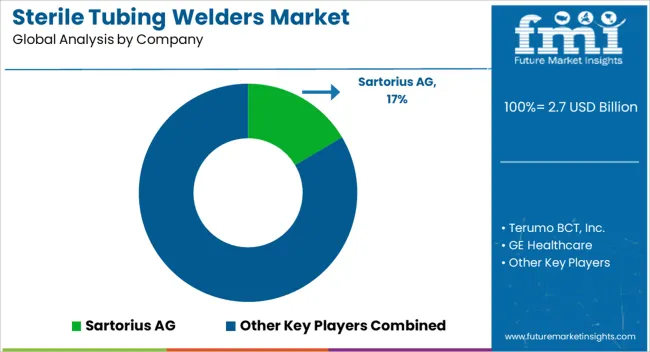
| Item | Value |
|---|---|
| Quantitative Units | USD 2.7 Billion |
| Application | Biotechnology, Pharmaceutical, Laboratories, and Others |
| Mode | Automatic and Manual |
| End Users | Hospitals, Research Clinics, Industries, and Others |
| Regions Covered | North America, Europe, Asia-Pacific, Latin America, Middle East & Africa |
| Country Covered | United States, Canada, Germany, France, United Kingdom, China, Japan, India, Brazil, South Africa |
| Key Companies Profiled | Sartorius AG, Terumo BCT, Inc., GE Healthcare, MGA Technologies, Vante Biopharm / Sebra., Genesis BPS, Biomen Biosystems Co., Ltd., SynGen, Inc., Sentinel Process Systems, Inc., Flex Concepts, Inc., and Shanghai Le Pure Biological Technology Co., Ltd. |
The global sterile tubing welders market is estimated to be valued at USD 2.7 billion in 2025.
The market size for the sterile tubing welders market is projected to reach USD 4.7 billion by 2035.
The sterile tubing welders market is expected to grow at a 5.7% CAGR between 2025 and 2035.
The key product types in sterile tubing welders market are biotechnology, pharmaceutical, laboratories and others.
In terms of mode, automatic segment to command 57.1% share in the sterile tubing welders market in 2025.






Our Research Products

The "Full Research Suite" delivers actionable market intel, deep dives on markets or technologies, so clients act faster, cut risk, and unlock growth.

The Leaderboard benchmarks and ranks top vendors, classifying them as Established Leaders, Leading Challengers, or Disruptors & Challengers.

Locates where complements amplify value and substitutes erode it, forecasting net impact by horizon

We deliver granular, decision-grade intel: market sizing, 5-year forecasts, pricing, adoption, usage, revenue, and operational KPIs—plus competitor tracking, regulation, and value chains—across 60 countries broadly.

Spot the shifts before they hit your P&L. We track inflection points, adoption curves, pricing moves, and ecosystem plays to show where demand is heading, why it is changing, and what to do next across high-growth markets and disruptive tech

Real-time reads of user behavior. We track shifting priorities, perceptions of today’s and next-gen services, and provider experience, then pace how fast tech moves from trial to adoption, blending buyer, consumer, and channel inputs with social signals (#WhySwitch, #UX).

Partner with our analyst team to build a custom report designed around your business priorities. From analysing market trends to assessing competitors or crafting bespoke datasets, we tailor insights to your needs.
Supplier Intelligence
Discovery & Profiling
Capacity & Footprint
Performance & Risk
Compliance & Governance
Commercial Readiness
Who Supplies Whom
Scorecards & Shortlists
Playbooks & Docs
Category Intelligence
Definition & Scope
Demand & Use Cases
Cost Drivers
Market Structure
Supply Chain Map
Trade & Policy
Operating Norms
Deliverables
Buyer Intelligence
Account Basics
Spend & Scope
Procurement Model
Vendor Requirements
Terms & Policies
Entry Strategy
Pain Points & Triggers
Outputs
Pricing Analysis
Benchmarks
Trends
Should-Cost
Indexation
Landed Cost
Commercial Terms
Deliverables
Brand Analysis
Positioning & Value Prop
Share & Presence
Customer Evidence
Go-to-Market
Digital & Reputation
Compliance & Trust
KPIs & Gaps
Outputs
Full Research Suite comprises of:
Market outlook & trends analysis
Interviews & case studies
Strategic recommendations
Vendor profiles & capabilities analysis
5-year forecasts
8 regions and 60+ country-level data splits
Market segment data splits
12 months of continuous data updates
DELIVERED AS:
PDF EXCEL ONLINE
Sterile Water Treatment System Market Size and Share Forecast Outlook 2025 to 2035
Sterile Rubber Stopper Market Size and Share Forecast Outlook 2025 to 2035
Sterile and Antiviral Packaging Market Forecast and Outlook 2025 to 2035
Sterile Packaging Market Size and Share Forecast Outlook 2025 to 2035
Sterile Dosage Form Market Size and Share Forecast Outlook 2025 to 2035
Sterile Prep-Pack Workstations Market Size and Share Forecast Outlook 2025 to 2035
Sterile Barrier Packaging Market Growth - Demand & Forecast 2025 to 2035
Analyzing Sterile Packaging Market Share & Industry Leaders
Global Sterile Injectable CDMO Market Analysis – Size, Share & Forecast 2024-2034
Sterile Medical Packaging Market
Sterile Wraps Market
Sterile IV Containers Market
Sterile Container Market
Sterile Lids Market
Sterile Oncology Injectable Market
Non-Sterile Liquids Suspensions Market Size and Share Forecast Outlook 2025 to 2035
Global Non-Sterile Outsourcing Market Analysis – Size, Share & Forecast 2024-2034
Poly Tubing Market
Mobile Sterile Units Market Analysis – Growth, Applications & Outlook 2025–2035
Coiled Tubing Market Analysis by Service, Operation, Application and Region Through 2035

Thank you!
You will receive an email from our Business Development Manager. Please be sure to check your SPAM/JUNK folder too.
Chat With
MaRIA